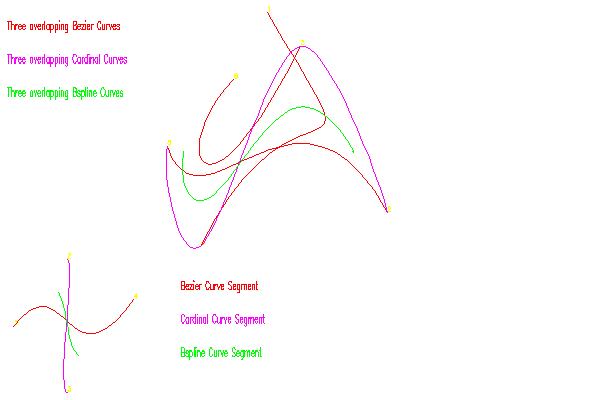C Library Functions - curve (3)
NAME
curve(3f) - [M_draw:CURVE] Draw a curve. (LICENSE:PD)
CONTENTS
Synopsis
Description
Examples
SYNOPSIS
subroutine curve(geom)
real geom(3,4)
DESCRIPTION
Draw a curve.
EXAMPLES
Sample Program:
program demo_curve ! ! using curves ! use M_draw implicit noneinteger i, idum, ios character(len=50) :: buf real bezier(4, 4), cardinal(4, 4), bspline(4, 4) real geom1(3, 4), geom2(3, 6) ! ! curve basis types ! data bezier / & & -1.0, 3.0, -3.0, 1.0, & & 3.0, -6.0, 3.0, 0.0, & & -3.0, 3.0, 0.0, 0.0, & & 1.0, 0.0, 0.0, 0.0 & & /
data cardinal / & & -0.5, 1.5, -1.5, 0.5, & & 1.0, -2.5, 2.0, -0.5, & & -0.5, 0.0, 0.5, 0.0, & & 0.0, 1.0, 0.0, 0.0 & & /
data bspline / & & -0.166666, 0.5, -0.5, 0.166666, & & 0.5, -1.0, 0.5, 0.0, & & -0.5, 0.0, 0.5, 0.0, & & 0.166666, 0.666666, 0.166666, 0.0 & & /
! ! Geometry matrix to demonstrate basic spline segments ! data geom1 / & & -180.0, 10.0, 0.0, & & -100.0, 110.0, 0.0, & & -100.0, -90.0, 0.0, & & 0.0, 50.0, 0.0 & & /
! ! Geometry matrix to demonstrate overlapping control points to ! produce continuous (Well, except for the bezier ones) curves ! from spline segments ! data geom2 / & & 200.0, 480.0, 0.0, & & 380.0, 180.0, 0.0, & & 250.0, 430.0, 0.0, & & 100.0, 130.0, 0.0, & & 50.0, 280.0, 0.0, & & 150.0, 380.0, 0.0 & & /
print*,’Enter output device:’ read(*,’(a)’,iostat=ios) buf if(ios.ne.0)buf=’ ’
call vinit(buf)
call ortho2(-200.0, 400.0, -100.0, 500.0)
call color(D_BLACK) call clear()
call color(D_YELLOW)
call textsize(10.0, 10.0) ! ! label the control points in geom1 ! do i = 1, 4 call move2(geom1(1, i), geom1(2, i)) write(buf, ’(i1)’)i call drawstr(buf) enddo ! ! label the control points in geom2 ! do i = 1, 6 call move2(geom2(1, i), geom2(2, i)) write(buf, ’(i1)’)i call drawstr(buf) enddo ! ! scale the current font so that 30 of the largest characters ! in the current font will fit in a region 300 world units wide, ! 20 high. ! call boxfit(300.0, 20.0, 30)
! ! set the number of line segments appearing in each curve to 20 ! call curveprecision(20)
! ! copy the bezier basis matrix into the curve basis matrix. ! call curvebasis(bezier)
call color(D_RED)
! ! draw a curve using the current basis matrix (bezier in this case) ! and the control points in geom1 ! call curve(geom1)
call move2(70.0, 60.0) call drawstr(’Bezier Curve Segment’)
call move2(-190.0, 450.0) call drawstr(’Three overlapping Bezier Curves’)
! ! curven draws overlapping curve segments according to geom2, the ! number of curve segments drawn is three less than the number of ! points passed, assuming there are a least four points in the ! geometry matrix (in this case geom2). This call will draw 3 ! overlapping curve segments in the current basis matrix - still ! bezier. ! call curven(6, geom2)
idum=getkey() ! ! load in the cardinal basis matrix ! call curvebasis(cardinal)
call color(D_MAGENTA)
call move2(70.0, 10.0) call drawstr(’Cardinal Curve Segment’) ! ! plot out a curve segment using the cardinal basis matrix ! call curve(geom1)
call move2(-190.0, 400.0) call drawstr(’Three overlapping Cardinal Curves’) ! ! now draw a bunch of them again. ! call curven(6, geom2)
idum=getkey() ! ! change the basis matrix again ! call curvebasis(bspline)
call color(D_GREEN)
call move2(70.0, -40.0) call drawstr(’Bspline Curve Segment’) ! ! now draw our curve segment in the new basis... ! call curve(geom1)
call move2(-190.0, 350.0) call drawstr(’Three overlapping Bspline Curves’) ! ! ...and do some overlapping ones ! call curven(6, geom2)
idum=getkey()
call vexit()
end program demo_curve
| Nemo Release 3.1 | curve (3) | June 29, 2025 |
